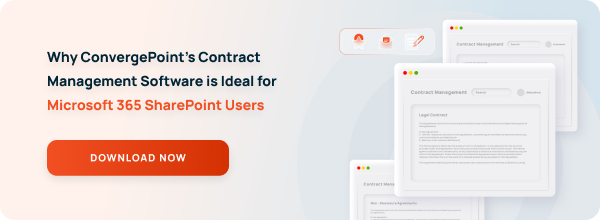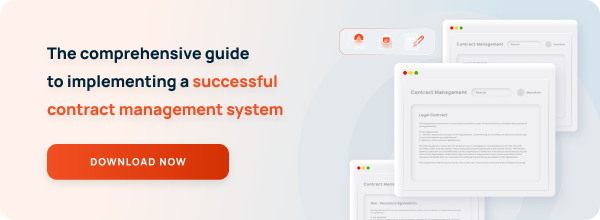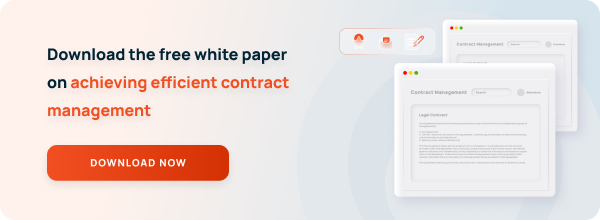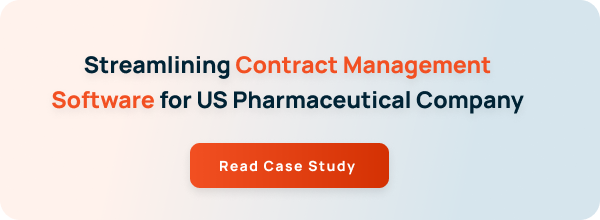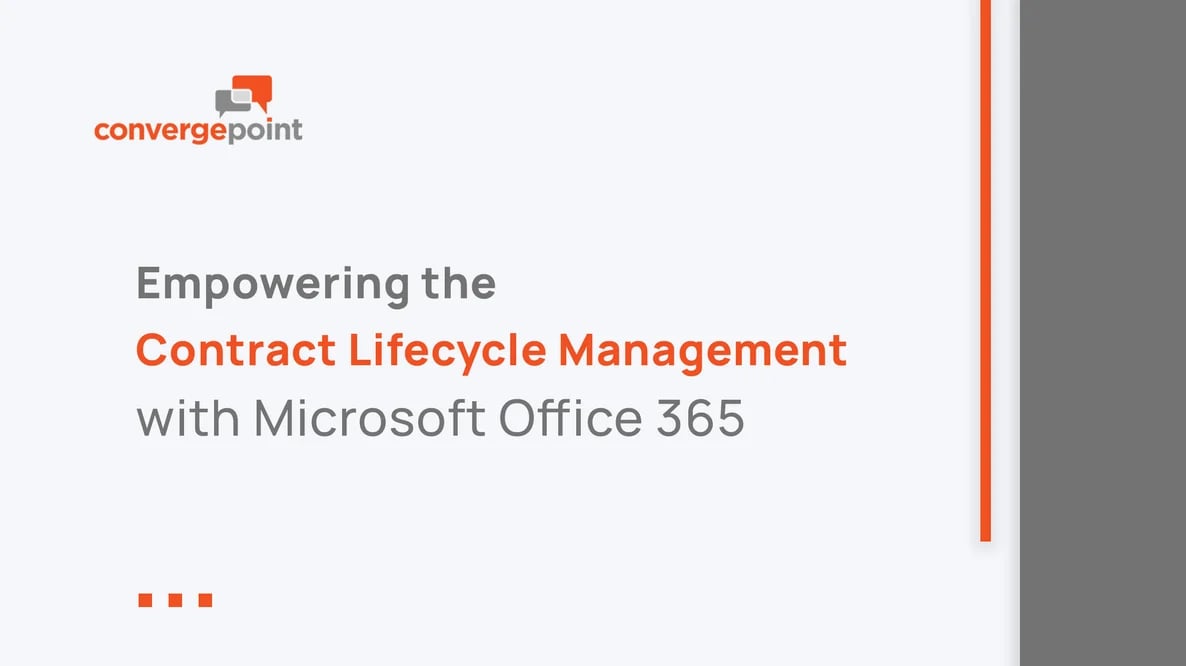
How to choose the right enterprise contract lifecycle management solution for your organization? - Top 6 Considerations for 2025
It’s easy to get nervous and overwhelmed when you are tasked with choosing a new contract lifecycle management (CLM) solution that will suit your organization.
Whatever you choose, you will likely be obligated to use it for the foreseeable future, so it must comply with every possible use case. It also needs to be scalable so it can grow with your organization, and it must not exceed the budget.
In this article, we’ve outlined important criteria to look for in a top-notch (CLM) solution and how ConvergePoint Contract Management solution can help your organization to overcome compliance challenges. These criteria are designed to help you select by focusing on what truly matters—ease of use, integration capabilities, advanced automation features, or top-tier security measures.
By understanding these essential factors, you’ll be prepared to assess solutions effectively and confidently narrow your search quickly, provided you invest in a tool that aligns perfectly with your organization’s unique needs and long-term goals.
What to consider in enterprise contract lifecycle management (CLM) software?
Choosing the right Contract Lifecycle Management (CLM) solution involves evaluating numerous factors. Start by assessing your organization’s current requirements and long-term goals, then compare these against the features offered by the contract management tool.
Here are some important factors to overlook:
Addressing Current Challenges
Before selecting a CLM solution, identify the specific issues your organization faces. Are missed renewal dates, inefficient contract workflows, or limited contract visibility holding you back? A CLM tool like the ConvergePoint solution should solve these problems while driving measurable improvements in efficiency and accuracy.
Also read: A Step-by-Step Guide to Contract Management Software: Create, Negotiate, Review and Approve
Scalability
“What your business needs today may not be the same tomorrow”
Choose a CLM solution that can grow with your organization, adapting to a higher volume of contracts and more detailed workflows as your operations expand. Scalability provides your investment remains valuable in the long run.
Leveraging Advanced Features
Look for features like contract analytics, automated approvals, and customizable reporting dashboards. These tools can save time, reduce errors, and provide valuable insights to make informed decisions.
Prioritizing User Adoption
“Even the best CLM solution is ineffective if it’s not widely used.”
Opt for a CLM platform that is intuitive and user-friendly and provides comprehensive training and ongoing support to promote adoption across your team.
AI Functionalities
As the world shifts into AI-driven solutions, modern CLM software needs to integrate artificial intelligence functionalities to manage contracts. AI can automate repetitive tasks, such as contract review and approvals, and drastically reduce manual effort.
Advanced AI contract management tools allow organizations to gain deeper insights into contract performance, risks, and opportunities.
By leveraging AI, enterprises can improve contract accuracy, accelerate contract lifecycles, and ensure better compliance. Integrating AI-powered features into your CLM solution can position your company at the forefront of innovation in contract management.
Also read: How to Create Contracts Faster with AI Assisted Tools
With so many options available, the process can feel overwhelming. That’s why we’ve created the top 6 things to consider when choosing enterprise contract lifecycle management software:
1. One Central Repository
Choose a contract management solution that offers a single, secure, central repository. It will help your team save a lot of time if they can easily find the contracts and supporting documents they need at a moment’s notice. Be certain the CLM you select offers dashboards with easy viewing of the contracts under your purview for an even faster search and reference capability.
2. Contract Renewal and Expiration Alerts
When managing the lifecycle of a contract, it’s important that you are able to set up automatic reminders and leave a clear audit trail to help manage risk and avoid unwanted fines or renewal surprises. Consider choosing a solution that will work with your Active Directory or employee database to allow role-based access. This will allow you to set and control permissions based on a person’s role within your company, rather than their name or employee ID number.
Using Active Directory, for example, will enable your organization to nimbly shift control over various contracts to different employees based on their roles.
3. Contract Obligation Reminders and Notifications
It’s not uncommon for contracts to come with related obligations that need to be assigned out to employees in order to mitigate risk and ensure a productive contract lifecycle. Certificates of Insurance, for example, may need to be renewed annually while the contract itself has a renewal and expiration period that is every three years.
For these separate but related tasks, make sure your new contract management solution offers you the ability to assign out these obligatory tasks and send reminders to ensure each is completed on time.
4. Version History
The days of having to round up approvals and guess which version of a contract is the latest should be firmly behind you once you implement a new CLM solution. Choose software that manages this function for you, ensuring that no matter how you search or come across a contract document in the system, you can rest assured it is the latest version that you are viewing.
Make sure the software you choose maintains an audit trail showing who made what changes, too, for added compliance.
5. Customizable Templates
If your templates can be branded and customized to your business needs, your employees are more likely to use and reuse them, and your contracts will stay consistent and professional in appearance. Make sure your new CLM offers this functionality along with other ad hoc capabilities.
6. Seamless Integration
Find a software solution that integrates with your existing system, and you’ll have an easier time getting other departments to buy in. If the user interface is familiar to your colleagues who will be working within the CLM, it is far more likely they will be successful in adopting and using the new technology. IT typically requires new technology to integrate with existing platforms, so it’s a good idea to check with that department first.
For example, IT may recommend you choose a software application that will work with Microsoft Office 365 SharePoint—one of the most widely used platforms today. Choosing a solution that will work with these platforms will make any data migration simpler.
Once you find a CLM that offers all these features and works with your existing systems, you’ll notice an immediate return on investment when you see how much time you will save tracking down contracts and get value by automating the contract lifecycle management.
Get started on your contract lifecycle management journey with ConvergePoint
ConvergePoint offers the most trusted and leading contract management solutions, designed to seamlessly integrate with SharePoint and Microsoft Office 365. Our solution is designed to scale with the needs of any enterprise, ensuring that you can effectively manage contracts throughout their lifecycle, no matter the industry.
What sets ConvergePoint apart is not only its ease of integration but also its powerful features, such as automated workflows and AI-powered contract reviews, all within an intuitive interface. It’s a solution that helps you eliminate manual processes, reduce risks, and make smarter, data-driven decisions.
And the best part? ConvergePoint is designed to be an affordable option. No matter where you are in your contract management journey, we are here to support your growth and success.
Ready to see how ConvergePoint can help you choose your contract management? Schedule a demo today, and let’s get you started on the path to greater efficiency and streamlined contract processes!
Download Contract Management WhitePaper
Everything you need to know about ConvergePoint Contract Lifecycle Management (CLM)
How ConvergePoint contract management software handles contract lifecycle management (CLM)?
The software features a centralized repository for storing the executed contracts and handling post-execution activities. This includes recording the obligations of parties involved in the contract and tracking renewals and expiration.
How does a customizable contract request form feature in ConvergePoint contract management software streamline the contract life cycle management (CLM)?
ConvergePoint Contract Management Software allows organizations to customize the Contract Request form to meet their business requirements. Leveraging customized request forms streamlines the contract creation process by collecting all necessary information upfront, reducing back-and-forth communication, and ensuring that contracts are aligned with user requirements.
How does ConvergePoint contract management software speed up the contract review and approval process?
ConvergePoint Contract Management Software automates workflows for reviewing and approving contracts. This reduces manual steps and streamlines the approval process. Furthermore, it supports cross-functional collaboration and offers options to change the workflow based on the stakeholder availability during the review and approval stages of the Contract Life Cycle. This speeds up the approval process, reducing the Turn Around Time (TAT) taken for approving the contract, usually in the traditional manual approach.
How does ConvergePoint contract management software handle version control efficiently?
ConvergePoint Contract Management Software maintains an audit trail to track all changes made to a contract. This ensures transparency and prevents confusion and human errors.
How does ConvergePoint contract management software integrate with other systems?
ConvergePoint's contract management solution seamlessly integrates with various third-party applications, including CRM applications like Salesforce and Dynamics. To allow users to securely sign and manage contracts within the platform, it also integrates with web-based eSignature technologies like as DocuSign, EchoSign, and HelloSign.

